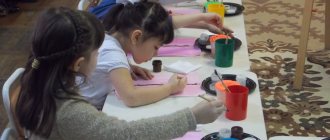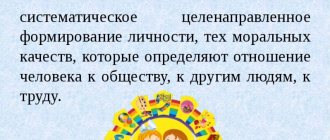- When to start developing?
- 6 tips for developing aesthetic taste
- How drawing develops aesthetic taste
What is aesthetic perception - the ability to understand art, the desire for beautiful things, the ability to harmoniously combine colors? This is a question many parents ask. There is no definite answer, but one thing is clear: aesthetic perception presupposes an emotional response to beauty. In an art school for children, the development of such a response is one of the goals of the program, but it is important to develop it in the home environment.
When to start developing?
From birth, a child learns to distinguish between the beautiful and the ugly. Bright, colorful and shiny objects arouse his interest; he reaches out to beautiful toys, listens carefully to the music his parents play, and looks at the sky and trees while walking. Parents draw the child’s attention: “look, what a beautiful cloud”, “what a bright flower” - and this lays the foundation for the formation of aesthetic thinking in the future.
The first response to beauty in children comes unconsciously, intuitively. However, in the future, aesthetic perception needs to be developed. In children's centers it is included in comprehensive development programs.
Aesthetic perception of the world is associated with a feeling of joy, inspiration, elation; this is a strong feeling of deep familiarity with beauty. People who have been brought up with such a feeling feel art more subtly. They have no destructive desire to spoil or destroy other people's work. They admire the beauty of nature and art, which means they treat them more carefully.
Useful tips
- support your child’s interest in art;
- do not use negative attitudes;
- engage in joint activities; lead by example.
To develop creative skills, you can use different drawing methods. For example, buy finger paints and paint with your palms. Another option is frontage. A relief object, for example, a coin, is placed under a sheet of paper and shaded.
You can buy ready-made creativity kits and disassemble them together. For example, coloring pictures by numbers or applique, felting toys is suitable.
Be sure to praise your child for showing interest. Do not interfere with his contemplation of the world around him and try to diversify the environment. For example, go to museums, parks, botanical gardens and other cultural places.
Talk with your child about abstract topics: about beauty, goodness, love, morality, aesthetics. Don’t be responsible for your preschooler—give him the opportunity to form his own opinion. Give hints as the conversation progresses.
How drawing develops aesthetic taste
One of the best ways to develop a child's aesthetic taste is to enroll him in drawing classes for children. During the learning process, the child learns not only to reproduce real images on paper or canvas, but also to see the essence, character, and mood of the picture being created. In addition, contact with your own feelings and emotions is restored. He can manifest them through drawings and live them safely in his creativity.
And during the classes, the teacher introduces students to the works of classics and modern artists. By comparing, finding similar things, forming his preferences, the child penetrates deeper into art and awakens a love for beauty in his soul.
Drawing lessons for children at the Children's Producer's School are structured in such a way as to reveal the artistic talent in each student, form imaginative thinking, develop fine motor skills and develop an aesthetic attitude towards the world around them.
We are waiting for your children at Names Production!
Components of education
To develop aesthetic ideas, a child needs to be introduced to music, literature, folklore, paintings and others. It would be good if all this surrounded him every day.
For example, you can hang reproductions of paintings. Choose ones that are appropriate for a specific time of year. For example, appropriate landscapes and still lifes with flowers are suitable for summer. Consider them, analyze them, talk about the details.
The situation is more complicated when listening to music. It is difficult for children to perceive it by ear for a long time. You can play children's instrumental pieces while brushing your teeth or after waking up. Tell your child about different musical instruments and compare different types of sounds.
Introduce your child to different types of folk art. You can try to repeat them in your creativity. For example, make Gzhel painting or Dulevo toys.
Aesthetic and ethical education of children in physical education lessons. 1-11 grades
Gymnastic compositions at school
Let's figure out what we can use for the aesthetic development of children. Of course, first of all, it is the ability to create combinations (compositions, connections). The most convenient for this are gymnastic compositions. To make it clearer for children, you need to explain to them the basic rules for composing a combination, give good examples and not so good ones.
First of all, students must understand two points:
1. The elements of the composition should smoothly transition into one another.
2. It is necessary to use only those elements that are already well known and that the guys can perform beautifully, and not haphazardly.
Here is an example of a gymnastic composition:
Do a “Swallow” - from a swallow, lean forward and do a somersault forward (with one leg out of balance on the left (right) right (left) back) crouched point-blank - roll back in a tuck, straighten your legs, touch your toes to the mat behind your head - roll into crouching emphasis - bending upward jump.
This is an example of a fairly simple composition, where all the elements flow smoothly into each other.
Now let's imagine that we mixed something up:
We perform a “swallow”, then we try to perform a back roll, and to do this we first have to sit down (performing an unnecessary, ugly movement), after performing a back roll, we return to the squat, after which we try to perform a forward somersault, etc.
With such a construction of the sequence of elements, the composition will no longer be a composition, it will turn into an ordinary set of elements. In this case, even if each individual element is made beautifully and aesthetically, all together they will end up in a very unattractive form.
The above-mentioned guidelines will be enough for younger schoolchildren, but you can try to acquaint older children with the whole other range of conditions under which the combination will look great and attractive, not only for the judges (if there are any), but also for the audience.
As we have already figured out, the process of composing a good gymnastic combination is a complex creative process. This is a kind of short theatrical performance, for this you can even use some image, for example, an animal - a hedgehog (which will look especially good in a group, curled up in a ball) when performing a forward somersault. It’s even more interesting if two people participate, one does the exercises, say a hedgehog, and the second is a fox that is chasing him. What could happen? Let's get a look:
The hedgehog runs to the mat, the fox follows him, there the hedgehog “stumbles” - he performs a forward somersault from a running start while crouching, the fox does not step on the mat, but runs around it and “catches” the hedgehog from the opposite side. He, escaping from the fox, rolls back (the fox grabs air), rocking slightly on his back, like a rocking chair, the hedgehog, seeing that the fox has calmed down, “relaxes” and straightens his legs (lies with his straight body on the mat). The fox “unexpectedly” tries to grab the hedgehog’s legs. He performs a stand on his shoulder blades (the beloved “birch tree”), the fox runs around from the side and again tries to catch the hedgehog by the legs, he lowers his legs towards himself and touches the mat behind his head. The fox runs around the mat in a circle, at which time the hedgehog straightens up (lies on the mat again). The fox tries to grab the hedgehog by the body, but he performs a bridge (the fox grabs the air under his back-bridge). Then the hedgehog “falls” with its back on the fox’s paws. The fox pulls its paws back and waves them as if it hurts, and the hedgehog performs a back flip (somersault), but not from a squat, but with its legs behind its head, completes the flip by completely turning over its head (if this element causes difficulties, then you can do it after touching the mat do not roll over with your feet behind your head, but roll forward point-blank while crouching), point-blank crouching. After which he performs a bending jump. Having landed beautifully and made a “scary” face, the hedgehog raises his hands threateningly. The fox is afraid and runs away, the hedgehog follows. End.
It turns out to be a whole theatrical performance. Then the former fox can show something different, and the former hedgehog can help her with this.
At first glance, everything written may seem cumbersome, but this is not so, everything will take very little time to complete. There are only 6 elements here, but there will be a lot more fun. In addition, such a theatrical composition will be a complete short performance, there is a beginning, a climax and an ending, everything is as it should be.
It's interesting to use just one mat rather than a trail of multiple mats for a composition. The path gives great freedom of action, but most often children are carried away by moving forward and do not even try to make various turns and U-turns. One mat adds complexity, but at the same time makes you think about how it is more convenient to compose a composition so that it turns out beautifully, and so as not to fall off the mat. Turns are also elements that require some skill and dexterity. For example, if we perform a forward somersault and come to a point-blank crouch, then it is much more difficult for us to turn beautifully, and if we perform a forward somersault with our legs crossed, then we will turn in a rather original way, simply spinning ourselves in the right direction (if the right leg is crossed in front, then we turn left, if it’s left, then, accordingly, right). Such little tricks can not only help in beautifully executing a composition, but will also teach children to select or invent the right moments, to pay attention to small, seemingly insignificant details.
The scene with the hedgehog and the fox can be performed quite easily on the same mat. But if a track made of mats is used, then it is advisable to pay attention to the force of inertia, since a large space provides greater opportunities for acceleration.
If we take a simpler option, then this is what can happen:
We start with the “Swallow”, move to a crouched position, then - roll forward into a sitting position with legs apart - bend forward - roll back, touch your toes to the mat behind your head - stand on your shoulder blades - lower your legs to a lying position - "bridge" - lie on the mat - We again raise our legs into a stand on the shoulder blades, but we don’t linger there, but immediately roll forward into a crouching position - forward somersault - bending jump. At the end, don’t forget to record the ending - we landed, stood up straight, and stood for two or three seconds. By this we show that we have stood up straight and no inertial force is pushing us anywhere (we have clearly fixed the pose).
More complex option:
“Swallow” - handstand or headstand - roll forward point-blank crouched - somersault back point-blank crouched - pushing off with your legs, stretch out with your whole body, land point-blank on your hands - do one or two push-ups - push off with your arms and legs, move into a push-up position crouched - somersault forward - forward roll - stop and fix the landing.
Of course, these are only approximate options that need to be refined and adjusted to each child. But the described options show successful transitions from one exercise to another. At that time, if you turn to the official physical education program, there is the following transition:
I. p. - “bridge”, and from the bridge you need to turn point-blank, lying down or just on your stomach. It’s hard to imagine a more clumsy transition. Well (so that it looks aesthetically pleasing), only a few can perform such a change of position, but the rest “squirm” in such a way that it’s scary to look at. What kind of aesthetics can we talk about in this situation? It’s not bad to just try this transition for yourself, but only a very well prepared child can use it in combination. Remember that each element learned adds a new brick to the child’s physical base of skills and abilities. But there is no need to accustom children to “clumsiness.” They can pick this up even without physical education. We need to teach them to use all the good things that exist in our area of skills and knowledge.
It is not always possible to prepare a large number of children for a performance, especially with different compositions (the set of elements to learn is still limited). But if you give the students the task of coming up with their own composition, using any exercises, elements or movements available to them, then it is quite possible that all the children will be able to prepare something of their own. Then it is interesting to hold mini-competitions (or just demonstration performances - which is even better), in which each child will show what he came up with, and other participants (plus parents, teachers, spectators) will applaud each performance. Of course, all children who have tried at least a little should not be offended by either attention or, if possible, gifts. Children must still understand that the beauty of the execution is assessed primarily, and not the complexity of the elements.
We have analyzed the composition for younger schoolchildren. Older guys, having a much larger motor base, can diversify their combinations with more complex elements. In addition, we remind them of a few more rules that they should follow when preparing:
- the originality of the elements - here it is necessary to explain that the elements do not have to be complex at all, these can be simple movements with the arms or legs that can be inserted into the main elements (for example, by performing a stand on the shoulder blades, you can make movements with the legs (step, spread and close straight legs, etc.); when performing a somersault forward, you can come to a squat with your legs apart (or legs together) and immediately bend forward, etc.). In addition, you can make interesting connections from ordinary simple elements. For example, after performing one or two circular movements with your arms forward, fall on the mat (absorbing the fall with your hands), do one or two push-ups, then, leaning on your hands, jump into a crouched position and then you can move on to somersaults and rolls, etc. d.;
- try to perform the elements so that the rhythm and tempo of the exercise changes. This does not mean that the rhythm should be jagged, in no case; on the contrary, everything should flow smoothly from one thing to another. For example, a static, slow start - balance on one leg, “swallow”, leaning forward (here you can add arm movements). Then the dynamic part - forward somersault, back roll, etc. (whichever student has the opportunity can insert elements of acrobatic breakdancing), etc. Then you can give the static part again - shoulder stand, bridge, etc. d. We must try to give a dynamic ending, this will add entertainment to the performance, and hence positive emotions for both the participant and the audience (fans);
— elements and connections must correspond to the individual motor characteristics of the child. It is necessary to warn children against trying to insert elements into their composition that they cannot perform or perform with great difficulty: if the child does not have very good flexibility and he cannot bend over so as to touch his toes with his hands, then, accordingly, it is not advisable to insert into his combination of a forward roll into a squat with a forward bend. From the outside, such a “clumsy” or “inflexible” tilt will ruin the whole impression, even if the somersault was performed wonderfully before. If you pay attention to competitions, you will notice that it is best for spectators, judges (and the athletes themselves) to remember the serious mistakes that were made during the performance and only secondarily the wonderful elements that turned out;
- it is advisable to instill in children the fact that each of them can have their own distinct individual style of performance, their own manner of performing exercises, their own dynamics - this, if desired, can even become the child’s calling card in the future; the audience will recognize him from the very beginning of the performance;
— the possibility of further improvement of the composition must be provided. Since doing the same thing all the time from year to year can get boring, the combinations need to be improved. But since constantly coming up with a new composition can be very problematic, you can use the main complex and weave into it new elements that will fit perfectly into the existing composition pattern. So, for example, if the previous time we only performed a back roll, now we can do a somersault. Or from the “swallow” we can perform not a bend followed by a somersault forward, but a handstand or headstand (provided that the child is able to perform these elements), etc. There is no limit to improvement. In addition, it is not at all necessary to focus only on the existing physical education program, we need to come up with something of our own or use what a variety of literature, TV, the Internet, various sports sections, etc., etc. can offer us;
- if we decide to hold a competition, then all possible mistakes must be identified, children must know for what the score is reduced and for what it can be increased. By the way, such an attitude can be useful when accepting any elements. For example, you need to pass the forward somersault technique, which we pay attention to: 1) tuck (it must be taken on time, neither before the start of the execution, nor after the rollover); 2) the head should not touch the mat (this can be explained not only from a technical point of view, but also from an aesthetic point of view, because it turns out very ugly when a child rests his head on the mat, and then begins to fall over his head trying to do a somersault. And so does his neck it can be damaged, and from the outside it looks scary); 3) after a somersault, you should immediately stand up and stop, recording the completion of the exercise.
When performing a composition, everything must be done clearly, movements must be flexible, smooth and correspond to the intended action. It is necessary to follow the line of movement. So, if you need to straighten your arms, then they should be really straight, and not bent at the elbows. It is advisable to pull your toes back, do not slouch your back, etc. And when performing a bending jump, you should try to bend over, and not just jump up, etc. For each mistake, you can award one penalty point, at the end of the competition, count who has these penalties there were fewer points (provided that all participants in the competition have an equal number of elements in the combination; if someone has fewer elements, the absence of this element is considered two errors, at the same time, you can add one point to the one who has more elements );
— you need to correctly distribute your forces across the entire combination. If you immediately start performing the entire dynamic part, then you may not have enough strength for simple static elements, because it will be much more difficult to maintain balance (for example, a “swallow” or a stand on one leg) after several somersaults than at the very beginning of the performance, so it is advisable to alternate dynamic elements with elements for flexibility or maintaining a pose;
— you need to combine the level of the student’s capabilities and the likelihood of success when performing the element. This means that you should not try to do something very difficult (for example, a handstand), but at the same time not be sure that this element will work (a couple of falls after an unsuccessful attempt to perform a handstand will add more mistakes to the piggy bank, than the advantages of doing it for the third time);
— there must be a fundamental possibility of organically combining selected parts or elements into one bundle (you need to be able to use connecting elements). If the elements cannot be connected in any way, then it is better to come up with a new connection, which may seem a little easier, but it can be made as beautifully and interestingly as possible;
— in the composition, continuity, dynamism, and unity of the exercise must be achievable.
To help children form their own composition, the teacher (educator, parent) should try to give them the maximum possible base of various elements. However, these elements must not be learned just for show, they must be performed very well. Learning complex elements (forward roll, headstand, handstand, etc.) can take quite a long time, so you need to start preparing in advance and it will be difficult to do without repeating these complex elements at home. However, if children become interested, they themselves will be happy to repeat the elements and motor actions they like at home without any reminder. Here, parents will most likely have to be more attentive and spend their personal time helping and insuring their children.
So, first, a base of gymnastic elements is formed, from which the combination (composition) will then be composed.
When the base is formed, you can begin to select the necessary (convenient, winning) elements. The selection of elements is carried out using the above principles. This issue must be approached with special attention; right now children have the opportunity to show all their creative abilities. Here, not only physical training plays a serious role, but also the correct, logically sound selection of elements.
When the required set of elements has been selected and the teacher and student have more or less decided, it is necessary to distribute it all over the entire combination. On the one hand, you can try to do complex elements at the beginning, while you still have a lot of energy, but on the other hand, you need to leave something for a spectacular ending, as in any film, theatrical production, even in a musical work, you always need a final chord, a memorable dot. In addition, when performing a complex element at the beginning of the composition, the student may make a mistake, which will then affect the further execution of the combination. For example, I tried to do a headstand, but the student couldn’t get into it the first time, he got frustrated and started making mistakes while doing other, easier elements. So one mistake gives rise to many others, which greatly spoils the entire performance. So there's a lot to think about here. If, for example, a child knows how to perform a kip-up from the floor, then (remembering the combination scene with the “fox” and the “hedgehog”) it can be performed at the end. Then the “hedgehog” gets up using a kip-up, and then scares and chases the “fox”. This ending can be especially effective if no one in the audience is previously familiar with it.
So, the individual elements have been learned, a spectacular ending has been invented, and now you can begin to distribute the entire set of available elements throughout the entire combination. Don’t forget to use all the above principles of composition. Let’s not forget the main thing - the connecting elements, the physical abilities of the performer and the entertainment value of the performance.
After the composition has been determined, all the elements have found their place, one last time you need to see if this combination can somehow be complicated or made even more spectacular and, having completely decided, we begin to learn. During learning, various nuances may emerge, for example, individual elements are performed wonderfully, but they don’t work together (this can happen with the same handstand: it’s one thing when you do a handstand on your own, separately from everything else, and another thing when you do it somersault forward, and then immediately transitions to a handstand - here inertia is added and the fact that your head may become slightly dizzy, etc.), then you have to adjust something, maybe even change it quite a lot. Or it can happen the other way around: a child who is not good at performing a forward somersault from a standing position can do it quite well from a run (the force of inertia helps), or the forward bend in the seat after a forward somersault can also turn out to be deeper. Having tried the entire invented combination and finally made sure that all the elements fit in as they should, that there are no delays, braking or, conversely, unnecessary flips, tilts, etc., only after that we begin to repeat the composition in order to improve and practice the holistic execution.
It is advisable to give all the basic provisions gradually as you master the physical education program, as you learn new exercises and elements.
You just have to try, and everything will definitely work out.






